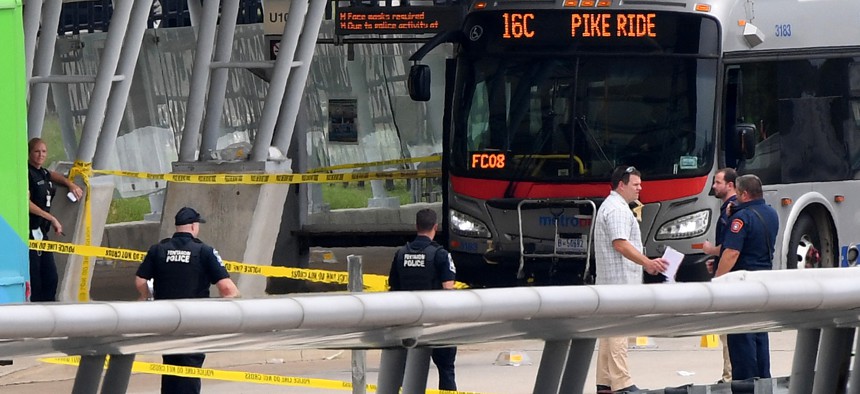
Law enforcement officers are seen at the metro bus platform outside the Pentagon after a shooting and lockdown August 3, 2021. AFP via Getty Images / OLIVIER DOULIERY
Pentagon Police Officer Dead, Several Other People Injured, After Attack at Metro Entrance
Shooting raises new questions about whether the public transit point just outside the military’s headquarters can ever be fully secured.
A police officer has died as a result of injuries sustained during a shooting at the Pentagon on Tuesday, Defense Secretary Lloyd Austin announced in a statement Tuesday evening.
“This fallen officer died in the line of duty, helping protect the tens of thousands of people who work in—and who visit—the Pentagon on a daily basis,” Austin said.
“We will keep the family of our fallen officer—and his fellow officers—foremost in our mind and provide them whatever support they require,” Austin said. “I hope they know we mourn with them.”
Several other people were injured in the shooting at one of the few public entrances to the military’s headquarters, raising questions about what additional force protection measures may be required for a building that has been the target of multiple attacks over the years.
Details about what spurred the attack are not available. An investigation “remains underway,” Austin said.
The attack began at about 10:37 a.m., when “a Pentagon police officer was attacked on the Metrobus platform,” said Pentagon Force Protection Agency chief Woodrow Kusse. “Gunfire was exchanged and there were several casualties.”
Shortly after the attack, a long procession of police cars escorted a van that transported a body to George Washington University Hospital and several news outlets confirmed the officer’s death, citing unnamed sources.
Kusse, his voice at times slightly shaking during a Pentagon press briefing Tuesday afternoon, would not provide additional details.
Several lawmakers and area law enforcement agencies also issued condolences for the loss.
“We mourn with law enforcement agencies near and far after the tragic loss of a @PFPAOfficial officer today. Our deepest sympathies are with the officer’s family, fellow officers and loved ones,” tweeted the Fairfax County Police Department.
Austin was at the White House when an aide alerted him of the attacks, said Pentagon spokesman John Kirby. Austin “very clearly was concerned about the incident, about the potential for violence right here in the Pentagon reservation.”
Kusse said the FBI has the lead in the investigation. Early media reports suggested a suspect was at-large, while others indicated the shooter was among those injured or killed.
Kusse would not confirm those details, except to say “we are not actively looking for another suspect.”
The Pentagon Force Protection Agency was formed in May 2002 in the wake of the Sept. 11 attacks.
Tuesday’s attack raised new questions about whether the Pentagon metro entrance was too vulnerable and whether additional security measures would be required.
“The Pentagon metro station is probably one of the busiest in the transportation system,” Kusse said. “It is a hub for commuters as well as building occupants. There are a number of measures that we have in place out there. Every time an incident occurs, whether it’s here or anywhere else … you do after-actions on those, you examine them, you look for things we can do to improve.”
“We will certainly, as this investigation concludes, take another look at any measures. Our mission is to protect not just the building but the community we serve that transits through that station,” Kusse said.
Since Sept. 11, the Pentagon has increased the security at the metro station and through the building; until that point, the metro entrance had allowed riders to walk directly into parts of the building.
In 2010, a gunman opened fire at the metro entrance, wounding two officers before being shot and killed.
The Pentagon fortified its entrances again in January after the attack on the U.S. Capitol with jersey barriers and fencing, but removed those additional measures in late spring.
The Pentagon metro bus facility is a cement-and-glass open-air stop that is a major connection and transfer station for routes. Dozens of buses pull through each hour to pick up and drop off passengers, many of whom do not work at the Pentagon but are transferring to a different bus route. The stop is monitored by multiple law enforcement agencies; to enter the Pentagon campus, a person must clear a fenced-off checkpoint.




